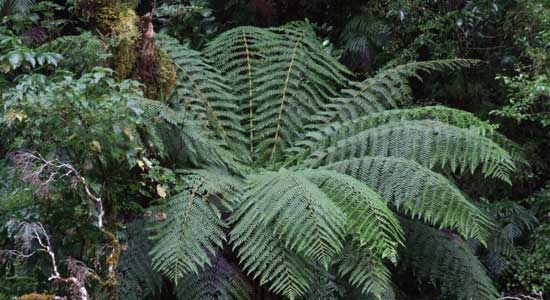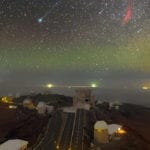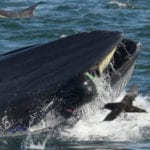 Weird Stuff
Weird Stuff  Weird Stuff
Weird Stuff  Mysteries
Mysteries 10 Tragic Disappearances and Deaths in Joshua Tree National Park
 History
History 10 Ways Childhood Really Sucked in the Old West
 Music
Music 10 Name Origins of Famous Bands from the 1990s
 Religion
Religion 10 Biggest Turnarounds by the Catholic Church
 Weird Stuff
Weird Stuff 10 Unbelievable Times Laws Had Unintended Consequences
 Humans
Humans Ten Historic Women Who Deserve Way More Credit Than They Got
 Movies and TV
Movies and TV 10 Films That Spawned Major Lawsuits
 History
History Ten Times Towns Were Wiped Off the Face of the Earth
 Creepy
Creepy 10 of the Most Disturbingly Haunted Public Houses in the UK
 Weird Stuff
Weird Stuff 10 Niche Subcultures That Are More Popular Than You Might Think
 Mysteries
Mysteries 10 Tragic Disappearances and Deaths in Joshua Tree National Park
 History
History 10 Ways Childhood Really Sucked in the Old West
Who's Behind Listverse?

Jamie Frater
Head Editor
Jamie founded Listverse due to an insatiable desire to share fascinating, obscure, and bizarre facts. He has been a guest speaker on numerous national radio and television stations and is a five time published author.
More About Us Music
Music 10 Name Origins of Famous Bands from the 1990s
 Religion
Religion 10 Biggest Turnarounds by the Catholic Church
 Weird Stuff
Weird Stuff 10 Unbelievable Times Laws Had Unintended Consequences
 Humans
Humans Ten Historic Women Who Deserve Way More Credit Than They Got
 Movies and TV
Movies and TV 10 Films That Spawned Major Lawsuits
 History
History Ten Times Towns Were Wiped Off the Face of the Earth
 Creepy
Creepy 10 of the Most Disturbingly Haunted Public Houses in the UK
10 Censored News Topics and Events
Censorship is the suppression of public communication that is considered to be objectionable, harmful or sensitive. Many different types of censorship exist, including moral, military, political, religious and corporate. Project Censored is a research group that tracks the news published in independent journals and newsletters. From these, they compile an annual list of 25 news stories of social significance that have been overlooked, under-reported or self-censored by the country’s major national news media. This year’s top three stories were Global Plans to Replace the Dollar, US Department of Defense is the Worst Polluter on the Planet and Internet Privacy and Personal Access at Risk. This article will examine ten censored topics and events.

On October 16, 2004, the journal Astronomy published an online article that discussed a new-found strewn field of impact craters in southeastern Bavaria, Germany. It reported on a field of impact craters stretching from the town of Altötting to the area around Lake Chiemsee. The strewn field falls within an ellipse 36 miles long and 17 miles (58 by 27 kilometers) wide, and may hold at least 81 impact craters ranging from 10 to 1,215 feet (3 to 370 meters) in size. A large collection of articles have been published in Germany on the subject. They suggest that Lake Tüttensee is the largest crater of the strewn field. It exhibits an 8 m-height wall, a rim-to-rim diameter of about 500m and a depth of roughly 30m.
According to the Chiemgau impact research team, physical and archeological research has placed the impact event between 700 and 300 B.C. which is during the Holocene epoch. The figure may be fine-tuned to around 200 BC (2,200 years ago), due to tree-ring evidence from preserved Irish oaks, which have showed a slow growth event around 207 BC. The impact is suggested to have come from a low density disintegrated, loosely bound asteroid or a disintegrated comet. In order to form Lake Tüttensee, the biggest chunk of the object would have smashed into the ground with a force equivalent to 106 million tonnes of TNT, or 8,500 Hiroshima bombs.
Research into the Chiemgau impact crater was started in 2000, after unearthed pieces of metal containing minerals not previously seen in the region were discovered, by amateur archaeologists who were digging around Lake Chiemsee. Additional evidence comes from local discoveries of Celtic artifacts, which appear to have been burned on one side. In addition, Roman authors during this time in history wrote about showers of stones falling from the skies. The Chiemgau impact crater is an obsolete theory that is not accepted by the scientific community. The claim has been refuted by geological research and the discovery of a soil horizon of undisturbed peat. According to scientific research, Lake Tüttensee is one of many Kettles under the foothills of the Bavarian Alps.

Operation Payback is the name given to a group of Internet activists who have been attacking opponents of Internet piracy, under the name “Anonymous.” In 2010, several Bollywood (Indian cinema) companies hired Aiplex Software to launch DDoS attacks on websites that did not respond to software takedown notices. In retaliation, piracy activists organized Operation Payback, in September 2010. Operation Payback has since conducted a wave of Internet attacks on major pro-copyright and anti-piracy organizations, law firms and individuals.
In September 2010, in an attempt to ensure that Portuguese citizens don’t access The Pirate Bay to download illegal music and videos, Associação do Comércio Audiovisual de Portugal (ACAPOR) filed a complaint with the government. In response, the ACAPOR website was defaced, presenting a speech from Operation Payback and a redirect to The Pirate Bay after a few seconds. On October 4, 2010, Operation Payback launched an attack on the Ministry of Sound London website and the Gallant Macmillian website. On October 15, 2010, Copyprotected.com was infected and defaced. Three days later Operation Payback launched a DDoS attack against the UK Intellectual Property Office.
In 2010, Gene Simmons of KISS was quoted as saying, “Make sure your brand is protected…Make sure there are no incursions. Be litigious. Sue everybody. Take their homes, their cars. Don’t let anybody cross that line.” In response, Operation Payback took his two websites offline. On October 26, 2010, LimeWire was ordered to disable the “searching, downloading, uploading, file trading and/or file distribution functionality” after losing a court battle with the RIAA. In retaliation, members of Operation Payback took the RIAA website down, on October 29.
In December 2010, WikiLeaks came under intense pressure to stop publishing secret United States diplomatic cables. Corporations such as Amazon, PayPal, BankAmerica, PostFinance, MasterCard and Visa froze donations to WikiLeaks due to political pressures. In response, Operation Payback directed their attention to the companies. On December 8, 2010, operation Payback brought down both the MasterCard and Visa websites. The attempt to take down Amazon was aborted after they failed to recruit enough users to their botnet. On January 27, 2011, five males aged between 15 and 26 were arrested in the U.K. on suspicion of involvement in Operation Payback.

The Mosquito is an electronic device that is used to deter loitering by young people. It emits a sound with a very high frequency. The device was invented by Howard Stapleton in 2005, and was originally tested in Barry, South Wales. The newest version of the device, launched in 2008, has two frequency settings, one of approximately 17.4 kHz that can be heard only by young people, and another at 8 kHz that can be heard by most people. The target age demographic for the device is 13 to 25-years-old. Children have the ability to hear higher frequency sounds than adults.
The Mosquito is sold as a small speaker that produces a high frequency sound much like the buzzing of an insect. The device is marketed as a safety and security tool for preventing youths from congregating in a specific area. In the UK, over 3,000 have been sold, mainly for use outside shops and near transport hubs. The Mosquito is also sold in Australia, France, Denmark, Italy, Germany, Switzerland, Canada and the USA. The device is spreading across the U.S. and Canada. It is used in many cities, municipalities, school districts and public parks. The Mosquito has attracted controversy. Critics say that the device discriminates against young people and infringes on human rights, especially if used in public location, such as a park, where teenagers are allowed to gather.
A large collection of people have filed suit over the device. The inventor, Howard Stapleton, has asked European governments to legislate guidelines governing its use. The German Federal Institute for Occupational Safety and Health has released a report that identifies a collection of possible safety hazards with The Mosquito. Lengthy exposure can be a problem for small children and infants. It can cause the onset of dizziness, headache, nausea and mental impairment.
The Mosquito has received support and endorsements from municipalities, school districts, property management companies, convenience stores and other organizations. A UK group called “Buzz off” is campaigning for The Mosquito to be banned. Shami Chakrabarti, director of Liberty, has claimed that the sound is “untested and unregulated” and that it can be a “sonic weapon directed against children and young people.” In an interesting twist, there is a Teen Buzz ringtone that has been marketed. It is used by some kids to prevent teachers from hearing their ring.

USA-193 was an American military spy satellite, launched on December 14, 2006. The craft’s precise function and purpose was classified. The satellite malfunctioned shortly after deployment, and was intentionally destroyed 14 months later, on February 21, 2008. It was shot down by a modified $9.5 million SM-3 missile, fired from the warship USS Lake Erie, stationed west of Hawaii. After the failure, the Federal Emergency Management Agency (FEMA) indicated that the satellite contained the hazardous materials hydrazine and beryllium. On January 29, 2008, an Associated Press story quoted a U.S. Air Force general as saying that a contingency plan was being made to destroy the satellite because intact pieces “might re-enter into the North American area.”
Planning for the destruction of USA-193 began on January 4, 2008, with President Bush approving the plan at an expected cost of $40 million to $60 million. The task force had the goal of “rupturing the fuel tank to dissipate the approximately 1,000 pounds (453 kg) of hydrazine, a hazardous fuel which could pose a danger to people on Earth.” The SM-3 missile was fired from the missile cruiser USS Lake Erie, and intercepted USA-193 about 133 nautical miles (247 kilometers) above the Pacific Ocean. At the time of impact, the satellite was traveling with a velocity of about 17,500 mph (around 28,000 km/h).
U.S. officials denied the accusation that the event was intended to prevent sensitive technology from falling into foreign hands. They also denied that it was a response to the 2007 Chinese anti-satellite missile test. The Russian government claims that the event was a test of the U.S. missile defense program. Russia accused the U.S. of using the hydrazine worries to cover up the test of an ASAT (Anti-satellite weapon).
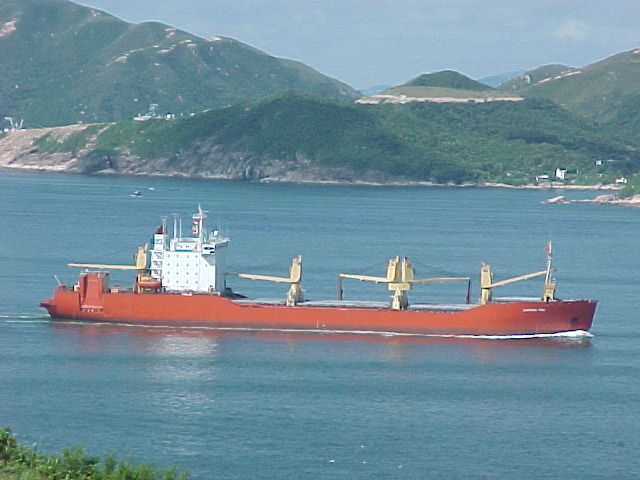
The Strait of Juan de Fuca is a large body of water about 95 miles (153 km) long. It forms the outlet for the Salish Sea to the Pacific Ocean and provides part of the international boundary between the United States and Canada. On April 4, 1997, a Russian merchant ship named the Kapitan Man was discovered to be anchored in the Strait of Juan de Fuca, approximately 5 miles (8.0 km) due north of Port Angeles, Washington. Responding to a request, the Canadian Forces dispatched a CH-124 helicopter to fly by the ship and take photographs of the vessel and its abnormal aerial antenna structure. The structure was indicative of a ship that may conduct ELINT or SIGINT intelligent gathering activities.
On board the helicopter was U.S. Navy Lt. Jack Daly and Canadian Forces pilot Capt. Patrick Barnes. Lt. Daly was the Navy’s foreign-intelligence officer in charge of a surveillance operation against Russian, Chinese and other spy ships operating in the Strait of Juan de Fuca and Puget Sound. This section of the United States is known for a large collection of major nuclear ballistic missile submarine and aircraft carrier bases. While taking photographs of the ship, Lt. Daly suddenly experienced an intense pain in his right eye and temporary blindness. After examination, it was concluded that Daly suffered direct laser burns to his eye, as well as other vision problems and severe headaches. Captain Barnes was also injured in a similar manner and was permanently grounded as a result of the incident.
Shortly after the attack, Coast Guard teams were given two hours to search the Russian vessel but did not locate a laser. Teams were not given full access to the ship and the Clinton administration had warned the Russian government in advance that it would be searched. The ZM-87 Portable Laser Disturber is suspected of being the weapon that was used against the U.S. and Canadian military. After the incident, Lt. Daly became adamant that the State Department had orchestrated a media cover-up of the espionage activity to avoid hindering international negotiations. Daly went so far as to say “According to the U.S. Constitution, Article III, Section 3, this cover-up was treason.”
An introduced species is a species living outside its native distributional range, which has arrived by human activity, either deliberate or accidental. Introduced species and their effect on the natural environment is a controversial topic. Perhaps the best area to study invasive species is on islands. Many bird species have evolved flightless on islands and are often threatened by invasive species. Introduced species regularly cause havoc on islands. A large collection of invasive species have spread across New Zealand.
The largest commercial crop in New Zealand is the Pinus radiata, which is the native Californian Monterey Pine tree. The pine tree grows great in New Zealand. However, the forests are also occupied by deer from North America and Europe and by possums from Australia. All of these animals are exotic species and they have thrived in the environment. Another pest is the common gorse, originally a hedge plant in Scotland. Like the Monterey pine, the gorse has shown to grow well in New Zealand. However, it is regarded as a noxious plant which threatens to obliterate native life.
Rabbits were introduced to New Zealand as a food source in the 1800s. They have since become a severe nuisance to farmers, notably on the South Island. Rats, dogs and cats have become a major problem for flightless birds. Sparrows, which were brought to control insects, have since displaced native birds. The longfin eels and other freshwater fish in New Zealand’s Lake Wairarapa are being forced to compete for resources with non-native fish. Two notable varieties of spiders have also been introduced to New Zealand. The white tail spider and the Red back spider. Both may have arrived via shipments of fruit.
As a large number of species have been introduced to New Zealand, some have accidentally escaped and caused problems in other areas of the world. One of the most notable examples is the New Zealand mud snail, which has become an invasive species in many countries. Almost without exception, the introduced species to New Zealand have been detrimental to the native flora and fauna. However, some, such as sheep and cows and the clover upon which they feed are important to the economy. Some species of flora have increased biodiversity.
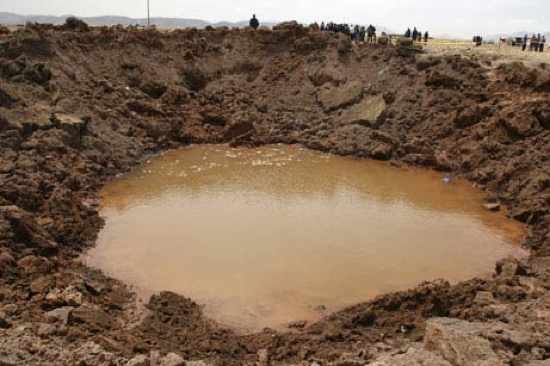
On September 15, 2007, a chondritic meteorite crashed near the village of Carancas, in the Puno Region of Peru, near the Bolivian border and Lake Titicaca. The explosion shattered windows at a health center located 1 kilometer (0.62 miles) away. The impact created a crater 4.5 m (15 ft) deep, 13 m (43 ft) wide, and scorched the Earth. The official size of the crater was given as 13.80 by 13.30 meters (45.28 by 43.64 feet). One of the first people to reach the area was a local official named Marco Limache. He reported a large amount of “boiling water coming out of the crater, and particles of rock and cinders nearby.” Limache gave a detailed description of how the crater was giving off a horrible smell.
Soon after the impact, over 600 villagers who had visited the site became ill from unexplained causes, including symptoms of dermal injuries, nausea, headaches, diarrhea and vomiting. On September 20, 2007, Peruvian scientists confirmed that there had been a meteorite strike, but no further information on the illnesses was released. Impact crater specialists have called the meteorite unusual. The ground water in the area is known to contain arsenic compounds, and the illness may have been caused by arsenic poisoning, but it has been argued that the arsenic content near the crater is no different from that of the local drinking supply. Another theory is that the illness was caused by the vaporization of troilite, which is a sulfur-bearing compound present in the meteorite.
All reports have indicated that the impact caused ground water in the area to boil for ten minutes. This has presented a problem for experts because meteorites are usually cold when they hit the ground. They don’t cause excessive heat. To explain this, the meteorite is said to have a high degree of iron and magnetic properties, similar to metallic objects. A large number of conspiracy theories have been connected with the impact. They revolve around the fact that the meteorite is unusual and the fireball was seen coming from a low trajectory. The most extreme conspiracy revolves around the claim that an extraterrestrial UFO entered the Earth’s crust. Other people have suggested the impact came from a U.S. spy satellite, the KH-13, which was destroyed in orbit. The explosive impact of the meteorite originally led Peruvians to think that the neighboring nation of Chile had launched an attack.

Since the beginning of the Gulf War, military personnel in the US and UK have displayed unexplained medical symptoms, including fatigue, headaches, joint pain, indigestion, insomnia, dizziness, respiratory disorders and memory problems, in addition to neurologic, neuropsychological, gastrointestinal and cardiovascular conditions. Approximately 250,000 of the 697,000 veterans who served in the Gulf War have been diagnosed with an enduring illness. The cause of the illness is unknown, but exposure to toxic chemicals has been identified as a culprit. This includes the exposure troops received after the destruction of the Khamisiyah weapons depot, where large quantities of Iraqi chemical munitions were stored, containing sarin and cyclosarin nerve agents.
Three large studies have been conducted that show a significant but modest increase in birth defects in children born to Gulf War veterans. Other Gulf War-related health issues include the rates of diagnosable medical conditions, cancer and post-war mortality among veterans. Aside from the many physical and psychological issues involved with war deployment, Gulf War veterans have been exposed to a unique mixture of hazardous substances. These include pyridostigmine bromide pills given to protect troops from the effects of nerve agents, depleted uranium munitions, and anthrax and botulinum vaccines. Military personnel also had to cope with swarms of insects, which required the widespread use of pesticides.
The Iraq War and the War in Afghanistan has displayed a more traditional rate of war time sickness. However, the bizarre symptoms of Gulf War illness are still visible. The current incident is centered on the high rates of respiratory, neurological and heart ailments. For VA benefit purposes, Gulf War service is defined as active military duty any time from the first Gulf War starting August 2, 1990 through the current conflict in Iraq. This includes veterans who served in Operation Iraqi Freedom (2003-2010) and Operation New Dawn (2010 and continuing).
Gulf War Veterans who meet the criteria do not need to prove a connection between their military service and medically unexplained chronic illness in order to receive VA disability compensation. VA presumes certain chronic, unexplained symptoms existing for 6 months or more are related to Gulf War service without regard to cause. Recent reports have indicated that U.S. troops in Iraq, Afghanistan and Kuwait have been confronted by a collection of harmful microscopic dust particles laden with toxic metals, bacteria and fungi. The dust contains 147 different kinds of bacteria, 37 metals, including aluminum, lead, manganese, strontium and tin, as well as fungi that could spread disease.

George Anthony Smith was a former footman and valet in the Royal Household of Prince Charles. In 1995, Smith made some startling accusations against the Prince of Wales and a man named Michael Fawcett. He alleged that he had been raped by Michael Fawcett, who was one of Prince Charles closest friends. Besides accusing Fawcett of rape, George Smith said that Michael Fawcett was in a homosexual relationship with the Prince of Wales, who protected him. The shocking news made some headlines in November 2003, and was the subject of a legal injunction in the United Kingdom to stop exposure.
George Smith’s claim of a sexual relationship between the Prince of Wales and Fawcett was repeated in a legal statement issued by him to the Mail on Sunday newspaper. In response, Michael Fawcett took a High Court injunction to prevent their disclosure. The injunction was granted. The Prince’s Private Secretary issued a statement denying the allegations and questioning the trustworthiness of the unnamed Smith as a source.
The story still cannot be published in England, Wales and Northern Ireland, but it has been written about extensively in the Republic of Ireland and Italy. Geoffrey Wheatcroft, a British media commentator, called Smith “probably the most unreliable source for any story on anything, anywhere in the United Kingdom.” George Smith claims to have only witnessed a member of the Royal Family and his aide “tucked up under the sheets, lying next to each other.”
In an interesting twist, George Smith discussed the matter with Diana, Princess of Wales. He told her that he had been raped. He also told Diana that he witnessed the Princess’s estranged husband, the Prince of Wales, lying in bed with his aide, Michael Fawcett. Diana is said to have taped the interview. The whereabouts of the tape became a matter of considerable controversy following Diana’s death, in August 1997. On August 24, 2005, George Anthony Smith died in Newport, Wales of an unknown illness. He was only 44-years-old.

The Climatic Research Unit (CRU) is one of the leading institutions concerned with the study of climate change. In November 2009, hackers gained access to a server used by the CRU and stole a large amount of data, anonymously posting online more than 1,000 emails and more than 2,000 other documents. The event occurred two weeks before the Copenhagen Summit on climate change. Following the leak, global warming skeptics began to highlight sections of the information that showed how scientists have manipulated statistics on climate change and suppressed their critics. The accusations have been denied by the CRU. CRU’s researchers stated that the emails were taken out of context and merely reflect an honest exchange of ideas.
According to Newsweek, climate skeptics believe that the documents show that global warming is a scientific conspiracy. In one email exchange, a scientist writes of using a statistical “trick” to illustrate historical trends in global warming. The Guardian’s analysis of the emails found that the hackers filtered the information using keywords, including Yamal, tree rings, and Phil Jones. The use of “tree rings” was an attempt to bring to notice the divergence problem. A large number of organizations released statements on the issue. The American Association for the Advancement of Science gave a quote, “There are multiple lines of scientific evidence that global climate change is caused by human activity. It is a growing threat to society.”
Six committees investigated the allegations and published reports, finding no evidence of fraud or scientific misconduct. However, the reports did criticize climate scientists for their disorganized methods, bunker mentality and lack of transparency. In several email exchanges, Kevin Trenberth, a climatologist at the National Center for Atmospheric Research, and other scientists discussed gaps in understanding. “The fact is that we can’t account for the lack of warming in 2009 and it is a travesty.” Overall, the incident was considered a public relations disaster for the scientific community. Historian Spencer R. Weart, of the American Institute of Physics, said the incident was unprecedented in the history of science, having “never before seen a set of people accuse an entire community of scientists of deliberate deception.”
